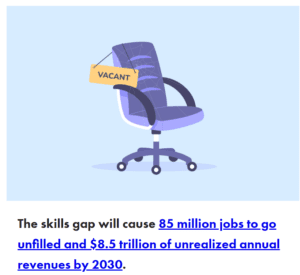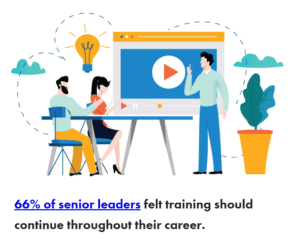Organizations can lessen the skills gap by training current employees, hiring for soft skills, and removing limitations from the hiring process.
By Tara Tapper
Tech companies have been grappling with the impact of The Great Resignation. As skilled employees jump to new opportunities, employers are left to deal with the skills gap, where the needs of an organization don’t match with what employees can actually do. The skills gap is found at all levels of an organization, including the C-Suite, and it will cause 85 million jobs to go unfilled and $8.5 trillion of unrealized annual revenues by 2030.
With the recent news of rescinded offers and layoffs in the tech industry, the skills gap is continuing to widen. And as the labor market remains inconsistent, employers need to reassess the way they look at their current employees and candidates to close the skills gap in their organizations.
Invest in Current Employees
The best way to shorten the skills gap is to prevent it from happening in the first place by ensuring that existing employees feel supported. Only about 34% of employees feel that their current company supports their professional growth and development.
It’s important to provide professional development and educational opportunities for all departments and levels. For example, as the digital transformation evolves and companies become more digitally native, everyone should receive training on IT, technology, cloud services, and more. This training should also continue as employees grow within the organization, as confirmed by a recent UK survey that found 66% of senior leaders felt training should continue throughout their career.
It’s also important to invest in creating the ideal candidate. Not all candidates start off in the industry employers are hiring for. By providing professional development and educational opportunities for those candidates who are interested, companies remove the barriers to access training and education programs and create potential candidates. Many organizations have developed their own training programs to provide knowledge and skills access to underrepresented communities that would normally not have access to tech training.
Closing the skills gap means being an active part of the solution. Therefore, leaders must reassess professional development programs and ensure they upskill and up-level current employees while providing opportunities for potential candidates.
Hire for Motivation and Mindset
Hiring diverse candidates can help close the skills gap, especially in industries like tech. However, many employers focus on a strict set of skills when hiring, which can limit the number of candidates in the pipeline. When employers create barriers to entry, they prevent potential candidates from being considered for necessary roles.
In tech, referrals and networking can put a candidate in front of the right recruiter. But not all candidates have the networks or skills necessary for this, which in turn means their resumes won’t even make it past the front door. This also creates a non-diverse environment since the majority of candidates who may not have access to connections, or the training required to get these skills may come from an underrepresented group. In tech, for example, Black and Hispanic/Latino workers only make up 7% and 8% of the workforce, respectively
Instead of looking at candidates who already have wide networks or already have hard skills, employers should focus on hiring those who have adjacent skill sets and have the potential and ability to grow within the organization. Soft skills, like communication, teamwork, and problem-solving, are hard to teach yet 73% of employers cite them as most important when hiring.
Organizations should look at candidates holistically. They may not have tech skills, but if they have the necessary soft skills and the drive to learn, they can be trained to acquire the hard skills.
Don’t Overcomplicate Search Efforts
The skills gap is also a self-inflicted problem. Most employers overcomplicate the recruitment process by asking for unnecessary requirements from the get-go. This is even more prevalent in the tech industry where positions have an exorbitant amount of requirements and call for the ability to manage niche technologies.
By complicating the process, employers open the door for candidates to self-select out of the process. This means employers are missing out on highly qualified individuals, including underrepresented candidates like women, who typically won’t apply to positions unless they feel 100% qualified.
This complication continues with the interview process itself, given the average interview process takes 23.7 days. Lengthy interviews can cause an additional barrier of entry for underrepresented communities who may not have the time or resources to tackle a complicated recruitment process.
Companies should also take a look at their recruitment and career pages and see if there is any language that may be turning away valuable candidates. It’s easy to declutter the requirements and focus on the skills that are truly essential to the job. And the same thing for the interview process: Is there a way to streamline the process to gather the information needed without scaring potentially good candidates away?
The skills gap is a major challenge for employers, but by investing in current and future employees, hiring for soft skills, and removing complications from the hiring process, organizations can mind the gap.
Tara Tapper is chief people officer for Cloudreach, an Atos Company
















